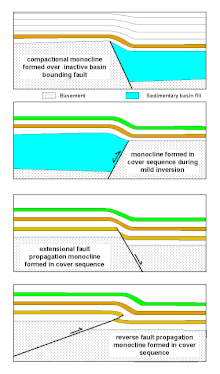A monocline (or, rarely, a monoform) is a step-like fold in rock strata consisting of a zone of steeper dip within an otherwise horizontal or gently-dipping sequence.
Formation

Possible modes of formation of monoclines
Monoclines may be formed in several different ways (see diagram)
- By differential compaction over an underlying structure, particularly a large fault at the edge of a basin due to the greater compactibility of the basin fill, the amplitude of the fold will die out gradually upwards.[1]
- By mild reactivation of an earlier extensional fault during a phase of inversion causing folding in the overlying sequence.[2]
- As a form of fault propagation fold during upward propagation of an extensional fault in basement into an overlying cover sequence.[3]
- As a form of fault propagation fold during upward propagation of a reverse fault in basement into an overlying cover sequence.[4]
Examples
- Waterpocket Fold in Capitol Reef National Park, Utah[5]
- Grandview-Phantom Monocline in Grand Canyon, Arizona[6]
- Grand Hogback in Colorado[7]
- Lebombo Mountains in Southern Africa[8]
- Lapstone Monocline in the Blue Mountains (Australia)[9]
- Beaumaris Monocline in Victoria (Australia)[10]
- Purbeck Monocline on the Isle of Purbeck, Dorset, England[11]
- Fore-Sudetic Monocline, Poland[12]
- Sindh Monocline, Pakistan[13]
- Torres Flexure, southern Brazil[14]
| This article uses material from the Wikipedia article Metasyntactic variable, which is released under the Creative Commons Attribution-ShareAlike 3.0 Unported License. |



